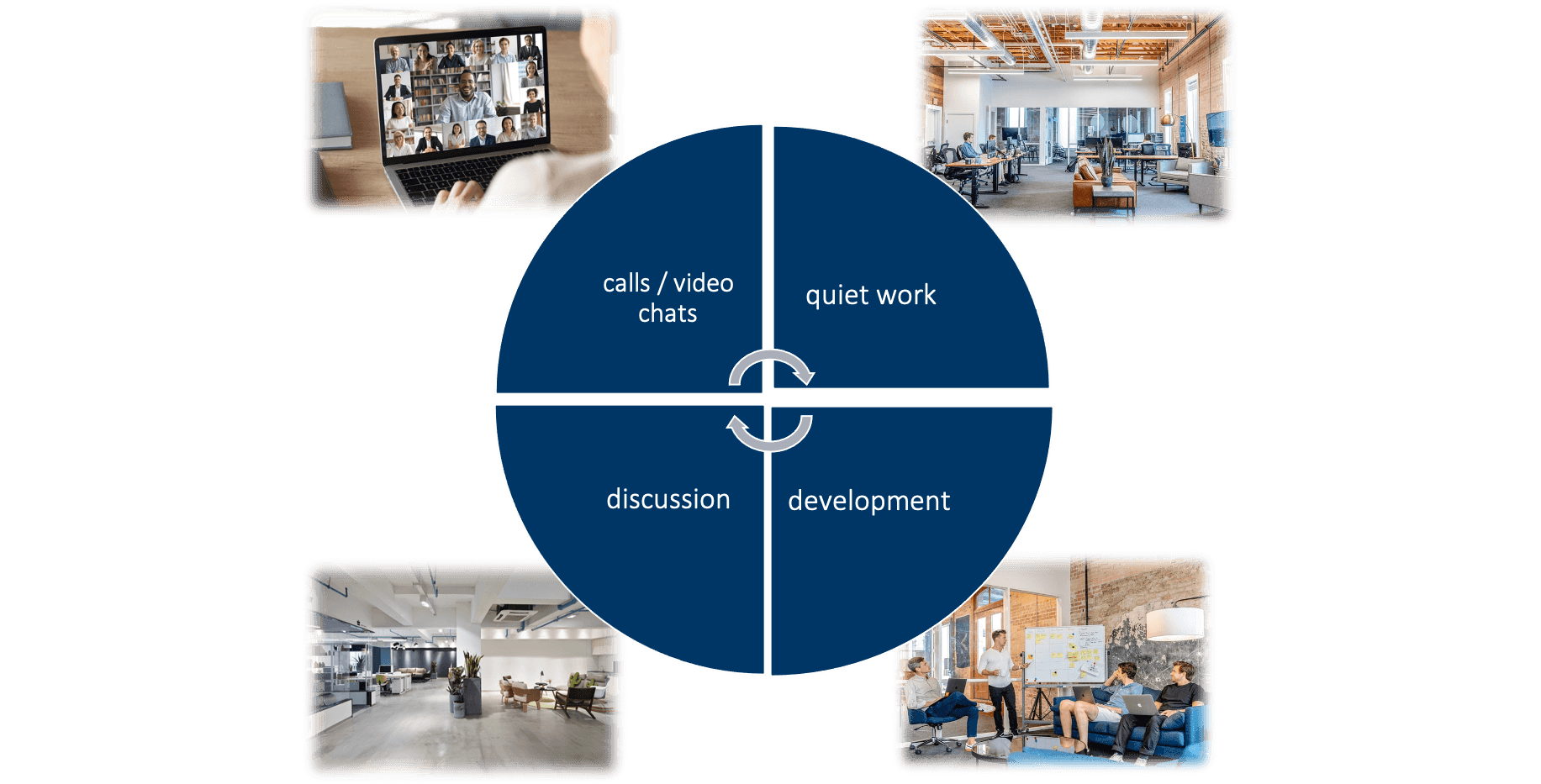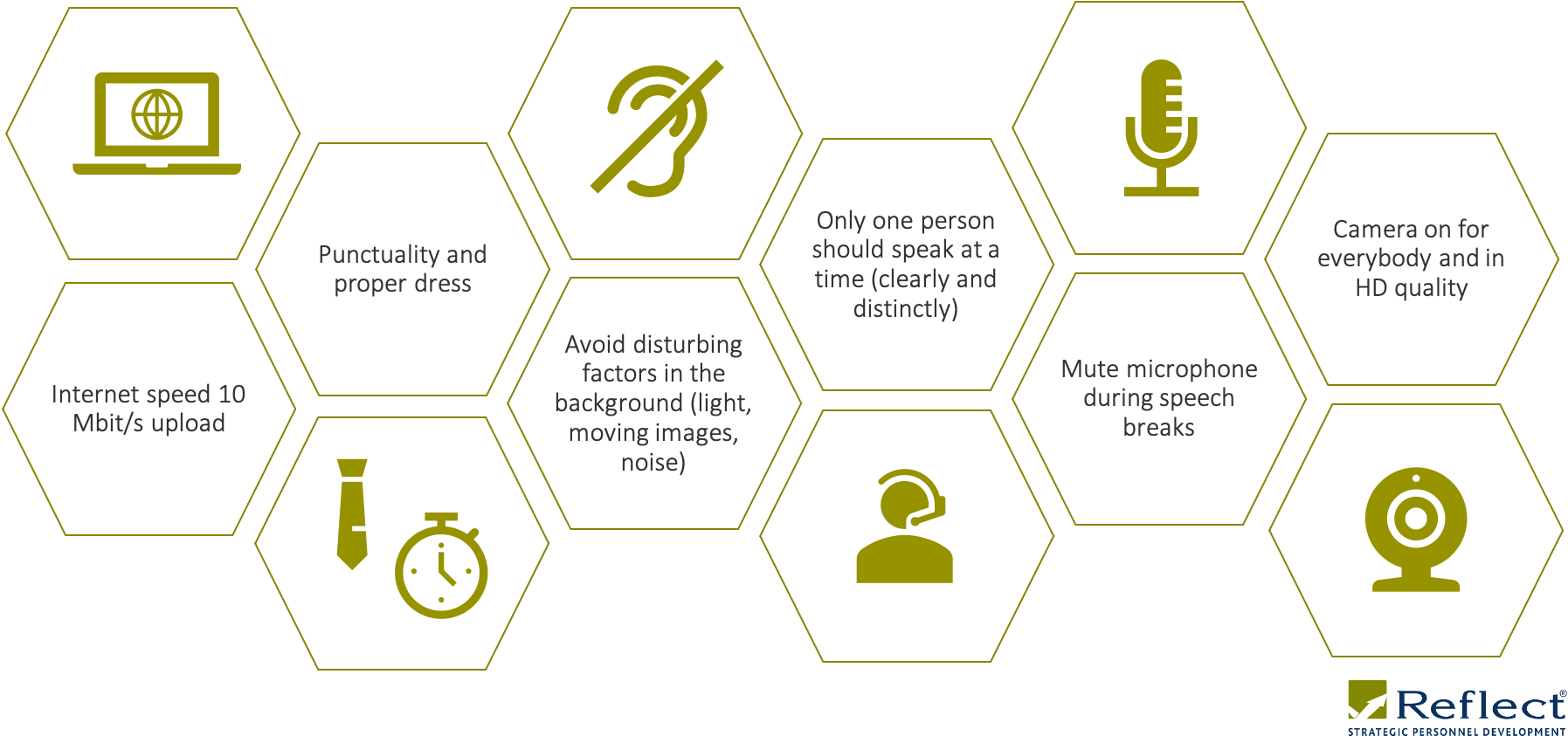The future of work - office or home office
As a result of the Corona-related measures, many employees are now working from home. According to a study by the IFO Institute in Munich, more than one in two companies in Germany intends to rely more on "home office" in the future and invest in digital infrastructure and new communication technologies.
But even without a pandemic, we are convinced that the world of work will change and an "anywhere ecosystem of work" will be the reality in the future.
Consequently, almost all companies are concerned with how they can organize work in the best possible way in the future.
One phenomenon we are currently seeing: quick, uniform solutions with the watering-can principle. This concerns the percentage distribution of office presence versus "home office hours". In our opinion, this maxim of action falls short. Why? Because the focus should be much more on WHAT employees actually do and WHERE they can do their work best.
We have already analyzed the advantages and disadvantages of the "home office" in the article New Work Model Home Office: Curse or Blessing?
But: What impact does the reorganization of work have when you can't just walk past someone else's desk? Will the office be obsolete in the future? What will everyday working life look like in 2022 at best, and which facets can already be taken into account in planning today?
Working modes
In the new working day of "New Work", different working modes determine the everyday working life of employees. These activities in turn place demands on the individual's environment so that everyone can develop their full potential in their work mode.

Figure 1: Working modes - future of work (REFLECT).
Quiet work
Quiet, concentrated working includes activities such as researching, reading, designing or creating concepts, writing and the like. Thus, the employee needs a very quiet environment where he/she will not be interrupted.
This work can be well shifted to the "home office", provided, however, that the employee has a study and does not have to raise children on the side. We all know the pictures from the past months.
Furthermore, when working in a "home office," it is important to exercise regularly, take breaks, and clearly delineate between work and the end of the day. This should ideally also be done spatially, as far as this is feasible.
Calls/video chats
This work mode includes a wide variety of activities, such as telephoning, video conferencing, coordinating, voting, sharing things. Activities like these are also well-suited for working from home. A fully equipped workplace and digital infrastructure, both in the office and at home, are important for successful implementation.
In addition to ergonomic office furniture, this also includes a fast Internet connection and appropriate hardware such as a computer, telephone or smartphone, headset, but also printer and scanner.
Discussion
This work mode is about collaboration with colleagues, in meetings, planning, coordination or the weekly "Jour fixe". In the office, a spacious meeting room with a digital whiteboard is recommended.
To make communication flexible for a distributed team, the team should be able to organize itself via a collaboration platform such as Microsoft Teams. This allows employees to dial into video conferences from home as well as from the office, share files, and track project progress with virtual work organization systems (Kanban, etc.).
Presence is generally recommended for meetings, but not essential. Experience shows that meetings can also run in a structured and efficient manner "online" with a larger number of participants. However, the sense of togetherness may be lacking, not all concerns may be mentioned, and attention may be severely limited.
Furthermore, it requires very good moderation skills should such meetings be conducted "online". Facial expressions and gestures play a significant role in communication, otherwise misunderstandings easily creep in, which are not noticed due to the missing non-verbal aspect.
Developing
Creative work represents the greatest challenge for "remote" working teams and their managers. At the same time, our VUCA world and global competition requires innovation like never before. Many an idea has only come about through chance encounters with colleagues.
We therefore recommend face-to-face events for workshops, design thinking sessions or even just for smaller "brainstormings" and idea presentations ("pitch day", "poster session", ...). This requires appropriate rooms in the company.
The space becoming available by increased "home office" can be converted and used effectively for this purpose. A reasonable equipment - often still a lack in many offices - can be provided. At present, many companies are saving considerable amounts of money by eliminating travel expenses, which can be well invested in infrastructure and technology.
Prerequisites for a successful home office:
Working in a "home office" lends itself to the above-mentioned "silent work" and "telephone/video" work modes; employees can efficiently implement these activities if the following prerequisites are met:
- Ergonomic workstation (height-adjustable desk, office chair, if necessary).
- Hardware (monitor, laptop, keyboard, mouse, headphones, telephone)
- Quietness to be able to work undisturbed
- Fast Internet connection
- Digital infrastructure (server structure, collaboration platform MS Teams or similar)
- Good self-organization (work-life balance must not become a burden)
- Observance of breaks
- Exercise, regular ventilation
- Healthy nutrition also in the home office
- Clear separation from work to create time for recreation
For the "discussion" work mode in particular, it is advisable to have a suitable collaboration platform in place and also to train managers in virtual leadership and teamwork. Generally applicable rules for behavior in video conferences, such as our REFLECT online netiquette, can be easily introduced (see Fig. 2).

Figure 2 Rules for video conferencing (REFLECT 2020).
For creative work and strategy sessions, we recommend face-to-face events. Here, in addition to creativity, the focus should be on strengthening the sense of community and corporate culture.
Conclusion:
Home office will have a permanent place in the future of work; it is particularly well suited for concentrated work modes. Therefore, every employee should be provided with a furnished workstation at home, insofar as this is spatially possible. In return, companies can reduce office space or convert existing space in a sensible way.
For many other activities, especially creative work, meetings, the joint coordination of work, orientation to goals, direct encounters are helpful and meaningful. This exchange is many times more effective in presence, because all senses are addressed and the component of chance and encounter is added.
We therefore recommend organizing the team in a "hybrid office". Whether in the end two fixed working days in the office make sense, or only one or four, would depend on the type of activity and the people involved.
We do not believe that blanket solutions that apply to all employees make much sense. Organizations should create a clear legal framework in which it is up to the teams to decide how they can best perform their tasks together.
Managers as well as employees can be regularly trained in virtual leadership and teamwork. When a lot of work is done from home, alternative formats are needed to strengthen togetherness, bonding, and identity building, as well as to cultivate a shared culture.
We recommend our guide to digital working for more in-depth reading. As a suitable workshop offering, we can recommend our online workshop Virtual Leadership and Teamwork.

